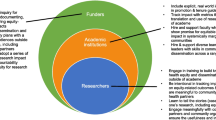Abstract
The Canada on the Move project developed within a dynamic context and in response to an expressed need for increased capacity to support research involving population-level interventions. This article describes a) the movement to create an organized approach to chronic disease prevention in Canada, b) the emerging science of population-level intervention, c) the development of Canadian infrastructure to support population intervention science, and d) the contribution of Canada on the Move in developing a health research platform and, opportunistically, instigating a study which included assessment of the population impact of a commercial marketing initiative.
Résumé
Le projet Canada en mouvement est né dans un contexte dynamique, en réponse au besoin manifeste d’accroître la capacité de soutien à la recherche sur les interventions axées sur la population. Notre article porte sur: a) le mouvement en faveur d’une approche structurée de la prévention des maladies chroniques au Canada, b) la science nouvelle des interventions axées sur la population, c) le développement d’infrastructures canadiennes à l’appui de cette science nouvelle et d) l’apport de Canada en mouvement à la création d’une plate-forme de recherche en santé et au lancement opportuniste d’une étude incluant une évaluation de l’impact sur la population d’une initiative de marketing privée.
Similar content being viewed by others
Bibliographie
Canada en mouvement, une initiative de l’Institut de la nutrition, du métabolisme et du diabète des Instituts de recherche en santé du Canada. Pour plus de détails, consulter la page de renseigne-ments https://doi.org/www.cihr-irsc.gc.ca/f/25687.html ou le site Web du projet: www.canadaenmouvement.ca.
Fries J. Aging, natural death and the compression of mortality. N Engl J Med 1980;303:130–35.
Mirolla M. The Cost of Chronic Disease in Canada, GPI Atlantic et l’Alliance pour la prévention des maladies chroniques au Canada [janvier 2004]. Sur Internet: https://doi.org/www.gpiatlantic.org/pdf/health/chroniccanada.pdf.
The North Karelia Project: 20 year results and experiences, sous la direction de P. Puska, J. Tuomilehto, A. Nissinen et E. Vartiainen, Helsinki (Finlande), Institut national de santé publique (KTL), 1995. Les chiffres cités sont tirés de: https://doi.org/www.ktl.fi/portal/english/osiot/research,_people_programs/epidemiology_and_health_promotion/projects/cindi/north_karelia_project/ [consulté le 10 octobre 2005].
Vartiainen E, Puska P, Pekkanen J, Tuomilehto J, Jousilanti P. Changes in risk factors explain changes in mortality from ischaemic heart disease in Finland. BMJ 1994;309(2):23–27.
Rose G. Sick individuals and sick populations. Int J Epidemiol 1985;14:32–38.
Rose G. The Strategy of Preventive Medicine, Oxford, Oxford University Press, 1992.
Green LW, Kreuter MW. Health Program Planning: An Educational and Environmental Approach, 4e éd. New York (New York), McGraw-Hill, 2005.
Abrams DB, Orleans CT, Niaura RS, Goldstein MG, Prochaska JO, Velicer W. Integrating individual and public health perspectives for treatment of tobacco dependence in managed care: A combined stepped-care and matching model. Ann Behav Med 1996;18(4):290–304.
Alliance pour la prévention des maladies chroniques au Canada. Pour plus de détails, voir: https://doi.org/www.chronicdiseaseprevention.ca.
Agence de santé publique du Canada. Pour plus de détails, voir: https://doi.org/www.phac-aspc.gc.ca.
Bauman A, Madill J, Craig CL, Salmon A. ParticipACTION a-t-il eu les effets visés? Rev can santé publique 2004;95 (Suppl 2):S14–19.
Hillsdon M, Cavill N, Nanchahal K, Diamond A, White I. National level promotion of physical activity: Results from England’s ACTIVE for LIFE campaign. J Epidemiol Community Health 2001;55:755–61.
Bauman A, Bellew B, Vita P, Brown W, Owen N. Getting Australia Active: Towards Better Practice for the Promotion of Physical Activity. Melbourne (Australie), National Public Health Partnership, 2002.
Bauman A, McLean G, Hurdle D, Walker S, Boyd J, van Aalst I, et al. Evaluation of the national “Push Play” campaign in New Zealand: Creating population awareness of physical activity. N Z Med J 2003;116:1179.
Nutbeam D. International Best Practices Workshop. Toronto (Ontario), Agence de santé publique du Canada, 2005.
Cameron R, Brown KS, Best AJ, Pelkman CL, Madill CL, Manske SR, et al. Effectiveness of a social influences smoking prevention program as a function of provider type, training method, and school risk. Am J Public Health 1999;89(12):1827–31.
Glasgow RE, Bull SS, Gillette C, Kleges LM, Dzewaltowski DA. Behavior change in health care settings: A review of recent reports with emphasis on external validity. Am J Prev Med 2002;23:62–69.
Green LW. The Science of Translating Science: To Get More Evidence-Based Practice, We Need More Practice-Based Evidence. Inédit, 2004.
Société canadienne du cancer. Pour plus de détails, voir: https://doi.org/www.cancer.ca.
Institut national du cancer du Canada. Pour plus de détails, voir: https://doi.org/www.ncic.cancer.ca.
Centre de recherche sur le comportement et d’évaluation des programmes de l’Université de Waterloo. Pour plus de détails, voir: https://doi.org/www.cbrpe.uwaterloo.ca.
Initiative canadienne de recherche pour la lutte contre le tabagisme. Pour plus de détails, voir: https://doi.org/www.ctcri.ca.
Instituts de recherche en santé du Canada. Pour plus de détails, voir: https://doi.org/www.cihr-irsc.gc.ca.
Santé Canada. Pour plus de détails, voir: https://doi.org/www.hc-sc.gc.ca.
Instituts de recherche en santé du Canada, Programme stratégique de formation en recherche sur le tabagisme. Pour plus de détails, voir: https://doi.org/www.ahs.uwaterloo.ca/cihr/training.
International Tobacco Control Policy Evaluation Project. Pour plus de détails, voir: https://doi.org/www.itcpro-ject.org.
Organisation mondiale de la santé. Convention-cadre pour la lutte antitabac. Pour plus de détails, voir: https://doi.org/www.who.int/tobacco/framework/en.
Newspaper Association of America. [Internet] [consulté le 3 novembre 2005] Facts about newspapers 2004–Canadian advertising expenditures–All media. Sur Internet: https://doi.org/www.naa.org/info/facts04/canada-allmedia.html.
Wenger EC, Snyder WM. Communities of practice: The organizational frontier. Harv Bus Rev 2000;78(1):139–45.
Author information
Authors and Affiliations
Corresponding author
French language version/Version en Français
41997_2006_BF03405358_MOESM1_ESM.pdf
Innovations dans la capacité de recherche sur les interventions axées sur la population: L’apport de Canada en mouvement
Rights and permissions
About this article
Cite this article
Cameron, R., Bauman, A. & Rose, A. Innovations in Population Intervention Research Capacity: The Contributions of Canada on the Move. Can J Public Health 97 (Suppl 1), S5–S9 (2006). https://doi.org/10.1007/BF03405358
Published:
Issue Date:
DOI: https://doi.org/10.1007/BF03405358




